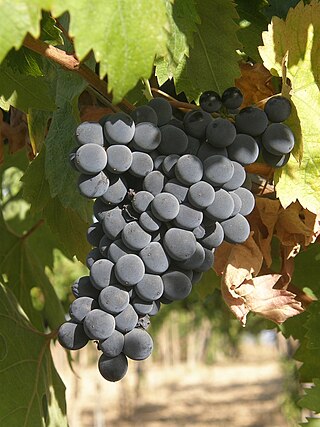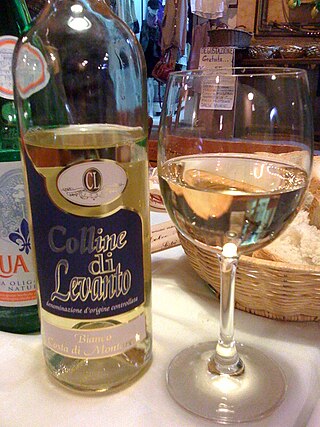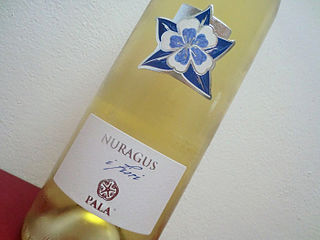
Verdicchio is a white Italian wine grape variety grown primarily in the Marche region of central Italy. The name Verdicchio derives from verde and refers to the slight green/yellow hue that wines made from the grape can have.

Trollinger, Schiava, or Vernatsch, is a red German/Italian wine grape variety that was likely first originally cultivated in the wine regions of South Tyrol and Trentino, but today is almost exclusively cultivated on steep, sunny locations in the Württemberg wine region of Baden-Württemberg. It is primarily known under the synonyms Trollinger in Germany, Vernatsch in South Tyrol and Schiava in other Italian regions. As a table grape the variety is sometimes known as Black Hamburg, which is commonly confused with the similar synonym for Black Muscat—a variety that is actually a cross of Trollinger and Muscat of Alexandria.

Vin Santo is a style of Italian dessert wine. Traditional in Tuscany, these wines are often made from white grape varieties such as Trebbiano and Malvasia, though Sangiovese may be used to produce a rosé style known as "Occhio di Pernice" or eye of the partridge. The wines may also be described as straw wines since they are often produced by drying the freshly harvested grapes on straw mats in a warm and well ventilated area of the house. Though technically a dessert wine, a Vin Santo can vary in sweetness levels from bone dry to extremely sweet. While the style is believed to have originated in Tuscany, examples of Vin Santo can be found throughout Italy and it is an authorised style of wine for several denominazione di origine controllata (DOCs) and indicazione geografica tipica (IGTs).

Montepulciano is a red Italian wine grape variety that is most noted for being the primary grape behind the DOCG wines Colline Teramane Montepulciano d'Abruzzo and Offida Rosso; and the DOC wines Montepulciano d'Abruzzo, Rosso Conero, and Rosso Piceno Superiore.
Verduzzo is a white Italian wine grape grown predominantly in the Friuli-Venezia Giulia region of northeast Italy. It is also found in significant plantings in the Piave Denominazione di origine controllata (DOC) of the Veneto region, though some of these plantings may be of the separate Verduzzo Trevigiano variety. Verduzzo Friulano is used in varietal and blended wines, many of which fall under DOC as well as vino da tavola designations, that range in style from dry to late harvest wines. According to wine expert Oz Clarke, most of the sweeter examples of Verduzzo can be found in the Friuli-Venezia Giulia with the grape being used for progressively drier styles of the wine the further west into the Veneto.

Bombino bianco is a white Italian wine grape variety planted primarily along Italy's Adriatic coast line, most notably in Apulia. The vine is prone to high yields and often produces neutral flavor wines. The grape is known under many synonyms throughout Italy including Debit and Pagadebit, names which came from the grape's reputation for being a high yielding and reliable crop for vineyard owners to grow that would assure them that on each vintage they could pay off their debts.
Perricone is a red Italian wine grape variety that is grown in Sicily. In the late 20th century there was around 1000 hectares/2,500 acres of the grape planted throughout the island. Red berry flavors and medium alcohol content are commonly attributed to Perricone wines, but Oz Clarke describes them as full-bodied and alcoholic.
Abrusco is a red Italian wine grape variety grown primarily in the Tuscany region where it is a minor blending component permitted in the wines of Chianti. The grape has long history in the region and was mentioned in 1600, under its synonyms Abrostino and Colore, in the posthumously published work by Italian agronomist Giovan Vettorio Soderini Trattato della coltivazione delle viti, e del frutto che se ne può cavare. There Soderini notes that the grape was often used to add deeper, more red color to Tuscan wines.
Bombino nero is a red Italian wine grape variety that is grown in southern Italy, particularly the regions of Apulia, Basilicata, and Lazio, as well as on the island of Sardinia. It is a permitted grape variety in the Denominazione di origine controllata (DOC) wines of Castel del Monte and Lizzano. The grape is primarily a blending grape but it can also be used as a varietal for red and rosé wines. Though DNA evidence has shown that Bombino nero is not a dark-berried color mutation of the similarly named Bombino bianco, ampelographers still believe that the two varieties are related in some way.

Liguria is an Italian wine region located in the northwest region of Italy along the Italian Riviera. It is bordered by the Piedmont wine region to the north, the Alps and French wine region of Provence to the west, the Apennine Mountains and the Emilia-Romagna wine region to the east with a small border shared with Tuscany in the south-east along the Ligurian sea.
Colline Lucchesi is a denominazione di origine controllata (DOC) for wine, created in 1968, that is located in northern Tuscany, Italy, and centered near the commune of Lucca.
Pollera nera is a red Italian wine grape variety that is grown primarily in the Liguria wine region and northwest Tuscany. Ampelographers believe that the vine has a very long winemaking history but it is rarely seen today. It is believed to have been descended from the Chianti wine grape Mammolo and the Corsican wine grape Sciacarello which would make it a half-sibling of Colombana nera.

Nuragus is a white Italian wine grape variety that is grown in Sardinia. It is the principle variety between the Denominazione di origine controllata wine Nuragus di Cagliari. The grape has a long history on the island with ampelographers believing that the variety was likely introduced to the area by the Phoenicians. While the grape is still widely planted in Sardinia its numbers began to dwindle in the late 20th century, falling by 50% during the 1980s alone to a total of 8,700 hectare in 1990. Today it is mostly found in the southern part of the island between Cagliari and Oristano on the hot Campidano plain.
Negrara is a red Italian wine grape variety grown in north east Italy including the Veneto region where it is a permitted variety in the Denominazione di origine controllata (DOC) wine Amarone. While the grape was once more widely planted in the region its numbers have been steadily declining for most of the late 20th and early 21st century.

Abruzzo is an Italian wine region located in the mountainous central Italian region of Abruzzo, along the Adriatic Sea. It is bordered by the Molise wine region to the south, Marche to the north and Lazio to the west. Abruzzo's rugged terrain, 65% of which is mountainous, help to isolate the region from the winemaking influence of the ancient Romans and Etruscans in Tuscany, but the area has had a long history of wine production.
Abbuoto is a red Italian wine grape variety that is grown primarily in the Lazio region of central Italy. Historically the grape was believed to be responsible for the Ancient Roman wine Caecubum that was praised by writers such as Pliny the Elder and Horace but historians and wine experts such as Jancis Robinson and Julia Harding note that connection is likely erroneous.
Bracciola nera is a red Italian wine grape variety that is primarily found in the Liguria and Toscana wine regions of western Italy. The only Denominazione di origine controllata (DOC) that Bracciola nera plays a significant role is in the Colli di Luni DOC of Ligura where the grape is permitted to be blended with Sangiovese, Canaiolo, Pollera nera, Ciliegiolo, Vermentino nero and other varieties. A late-ripening variety, Bracciola nera usually contributes acidity to blends.
Colombana nera is a red Italian wine grape variety that is grown in Emilia-Romagna and Tuscany. Despite similarities in name, the grape did not get its name from nor is it grown in the San Colombano al Lambro region of Lombardy nor is it permitted in the Denominazione di origine controllata (DOC) wine of the same name. Rather, ampelographers believe that Colombana nera is named after the Abbey of San Colombano located in the commune of Bobbio in the Piacenza province of Emilia-Romagna where the grape has had a long history of cultivation.

Vermentino nero is a red Italian wine grape variety that is predominantly grown in province of Massa-Carrara in Tuscany. After World War II, the vine was almost lost to extinction until Podere Scurtarola, a producer from Massa, began replanting old vineyards with the grape. By 2000, there were 199 hectares of Vermentino nero growing in Italy with the grape authorized for production in the Denominazione di origine controllata (DOC) wines of Candia dei Colli Apuani and Colline Lucchesi.
Barbera del Sannio is a red Italian wine grape variety that is grown in the Campania region of southern Italy. Despite the similarities in name and appearance, the grape has no close genetic relationship with the Piedmont wine grapes Barbera or Barbera bianca or the Sardinian wine grape Barbera Sarda and is, instead, more closely related to the Campanian varieties Casavecchia and Catalanesca and the Apulian grape Nero di Troia.









